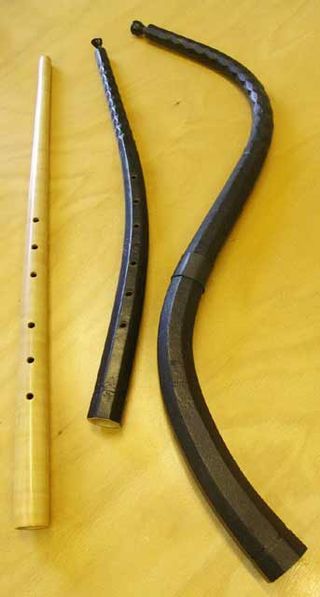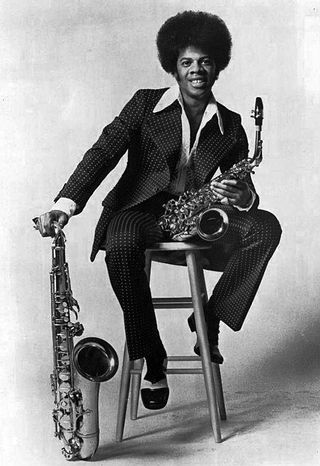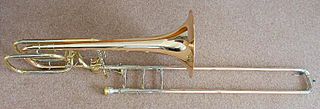
A brass instrument is a musical instrument that produces sound by sympathetic vibration of air in a tubular resonator in sympathy with the vibration of the player's lips. Brass instruments are also called labrosones or labrophones, from Latin and Greek elements meaning 'lip' and 'sound'.
In music, a glissando is a glide from one pitch to another. It is an Italianized musical term derived from the French glisser, "to glide". In some contexts, it is distinguished from the continuous portamento. Some colloquial equivalents are slide, sweep, bend, smear, rip, lip, plop, or falling hail. On wind instruments, a scoop is a glissando ascending to the onset of a note achieved entirely with the embouchure.

Renaissance music is traditionally understood to cover European music of the 15th and 16th centuries, later than the Renaissance era as it is understood in other disciplines. Rather than starting from the early 14th-century ars nova, the Trecento music was treated by musicology as a coda to Medieval music and the new era dated from the rise of triadic harmony and the spread of the ' contenance angloise ' style from Britain to the Burgundian School. A convenient watershed for its end is the adoption of basso continuo at the beginning of the Baroque period.

The term sackbut refers to the early forms of the trombone commonly used during the Renaissance and Baroque eras. A sackbut has the characteristic telescopic slide of a trombone, used to vary the length of the tube to change pitch, but is distinct from later trombones by its smaller, more cylindrically-proportioned bore, and its less-flared bell. Unlike the earlier slide trumpet from which it evolved, the sackbut possesses a U-shaped slide with two parallel sliding tubes, rather than just one.

The trombone is a musical instrument in the brass family. As with all brass instruments, sound is produced when the player's vibrating lips cause the air column inside the instrument to vibrate. Nearly all trombones use a telescoping slide mechanism to alter the pitch instead of the valves used by other brass instruments. The valve trombone is an exception, using three valves similar to those on a trumpet, and the superbone has valves and a slide.

The trumpet is a brass instrument commonly used in classical and jazz ensembles. The trumpet group ranges from the piccolo trumpet—with the highest register in the brass family—to the bass trumpet, pitched one octave below the standard B♭ or C trumpet.

The cornett, cornetto, or zink is an early wind instrument that dates from the Medieval, Renaissance and Baroque periods, popular from 1500 to 1650. It was used in what are now called alta capellas or loud wind ensembles. It was popular in Germany, where guild laws made it illegal for residents to play trumpets. As well, the mute cornett variant was a quiet instrument, playing "gentle, soft and sweet."

A transposing instrument is a musical instrument for which music notation is not written at concert pitch. For example, playing a written middle C on a transposing instrument produces a pitch other than middle C; that sounding pitch identifies the interval of transposition when describing the instrument. Playing a written C on clarinet or soprano saxophone produces a concert B♭, so these are referred to as B♭ instruments. Providing transposed music for these instruments is a convention of musical notation. The instruments do not transpose the music; rather, their music is written at a transposed pitch. Where chords are indicated for improvisation they are also written in the appropriate transposed form.

The bugle is a simple signaling brass instrument with a wide conical bore. It normally has no valves or other pitch-altering devices, and is thus limited to its natural harmonic notes, and pitch is controlled entirely by varying the embouchure.

The valve trombone is a brass instrument in the trombone family that has a set of valves to vary the pitch instead of a slide. Although it has been built in sizes from alto to contrabass, it is the tenor valve trombone pitched in B♭ which has seen the most widespread use. The most common valve trombone has three piston valves, and plays just like a trumpet but an octave lower. They are built in either short or long form.

The buisine and the añafil were variations of a type of straight medieval trumpet usually made of metal, also called a herald's trumpet. While arguably the same instrument, the two names represent two separate traditions, in which a Persian-Arabic-Turkic instrument called the Nafir entered European culture in different places and times.

A multi-instrumentalist is a musician who plays two or more musical instruments at a professional level of proficiency.

The bass trombone is the bass instrument in the trombone family of brass instruments. Modern instruments are pitched in the same B♭ as the tenor trombone but with a larger bore, bell and mouthpiece to facilitate low register playing, and usually two valves to fill in the missing range immediately above the pedal tones.

An alta cappella or alta musica (Italian), haute musique (French) or just alta was a kind of town wind band found throughout continental Europe from the thirteenth to the eighteenth centuries, which typically consisted of shawms and slide trumpets or sackbuts. Waits is the British equivalent. These were not found anywhere outside of Europe.

The alto trombone is the alto member of the trombone family of brass instruments, smaller than the tenor trombone. It is almost always pitched in E♭ a fourth higher than the tenor, although examples pitched in F are occasionally found. The alto trombone was commonly used from the 16th to the 18th centuries in church music to strengthen the alto voice, particularly in the Mass. Alto trombone parts are usually notated in alto clef.

Clarion is a name for a high-pitched trumpet in the Middle Ages and the Renaissance. It also is used as a name for a 4' organ reed stop, producing high-pitched or clarion-like sound on a pipe organ, and playing the clarion trumpet's range of notes.

Classical music generally refers to the art music of the Western world, considered to be distinct from Western folk music or popular music traditions. It is sometimes distinguished as Western classical music, as the term "classical music" also applies to non-Western art music. Classical music is often characterized by formality and complexity in its musical form and harmonic organization, particularly with the use of polyphony. Since at least the ninth century it has been primarily a written tradition, spawning a sophisticated notational system, as well as accompanying literature in analytical, critical, historiographical, musicological and philosophical practices. A foundational component of Western Culture, classical music is frequently seen from the perspective of individual or groups of composers, whose compositions, personalities and beliefs have fundamentally shaped its history.
The contrabass trombone is the lowest instrument in the trombone family of brass instruments. First appearing built in 18′ B♭ an octave below the tenor trombone, since the late 20th century it has largely been supplanted by a less cumbersome bass-contrabass instrument pitched in 12′ F, a perfect fourth below the tenor and bass trombone. Wagner notably specified the contrabass for his Der Ring des Nibelungen opera cycle in the 1870s, and it has since appeared occasionally in large orchestral works without becoming a permanent member of the modern orchestra. In the 21st century it has enjoyed something of a revival, particularly in film and video game soundtracks.

Music technology is the study or the use of any device, mechanism, machine or tool by a musician or composer to make or perform music; to compose, notate, playback or record songs or pieces; or to analyze or edit music.



















